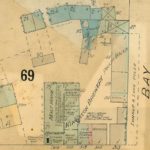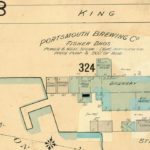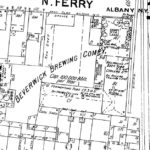




It was the best of times and insurance maps. It was the worst of times, you know, and… insurance maps. Errr. a tale of two cities of sorts, I suppose. From the upper left we have the Kingston Brewery as well as Portsmouth Brewing of my town from 1908 plus, to the upper right, the Albany Brewing Company, then below left Beverwick Brewing Company and, lower right, Taylor Brewing and Malting all of Albany in 1892. What can we learn from these images? Click on each image and find out for yourself. Here is what I see:
♦ UL: As discussed last August, the Kingston Brewery dates from at least 1791. The badly digitized 1824 map shows a set of buildings on the inland side of the inner harbour road. The 1908 map shows much of the same complex built up overtime. The malt kiln, laid with iron tiles, is no longer used and a lot of space is dedicated to ice houses as part of the lager operations. And there is a manure pit. Dangers which might be faced by fire crews are noted. Where a boiler might be found or a pump. The notes state that hoses are distributed meaning there is water throughout. The basic set up is a courtyard. There is a four story tower as well as a basement with a fermentation room and a stock cellar.
♦ UM: By comparison, Portsmouth Brewing in is more orderly. Based more about access to the lake than the older cross town competition. The kiln is on the land side of the property and leads into the brewery proper which leads to the bottling room. The coal and barrel sheds are separate. There is a basement and the main building is three stories high. Our commentator Steve Gates, author of The Breweries of Kingston and the St. Lawrence Valley has an excellent photo of the brewery from the next year taken from the vantage of someone under the letter “F” in “Fisher” as shown on the map. He also tells us that they had been brewing lager since 1872. Hence the ice house.
♦ UR: Next, the Albany Brewing Company neatly fills a city block as this picture from the coal shed view of 1865 to 1870 shows. I am sure there is a very good reason that hand grenades were distributed throughout the brewery for fire fighting purposes but I am not sure what that might be. Unlike the Kingston breweries above or Taylor below, there is no access to waterfront. Unlike Beverwick below, there is no train spur leading to the building. To the right center, there is a five story tower where it appears the coolers are located. The office is across the street to the south and a police station to the north. It’s in the middle of things. Looks like there are horse stalls near the coal shed that open out on to Green Street to the left of the image.
♦ LL: The Beverwick Brewing buildings appear to be more modern again. Founded in 1878, it has a rail siding… which apparently leads it to be suitable for a model railway set. The main building looks impressive. Five stories with a sixth in the attic. Brick arched ceilings on multiple floors frame fermenting tubs and beer tubs. Coolers are located in the fifth floor. A more compact footprint but, at 100,000 barrels a year, very productive and, therefore, famous. A very industrial set up compared to the others.
♦ LR: Last, good old Taylor Brewing in its elder years. The neighbouring buildings have been left vacant with only the core brewery seemingly in operation. Six stories very much oriented towards the river. When I saw this and saw the images of de Hooch yesterday, its position by the water looked like Dutch breweries lined up along the shore in Haarlem in 17th century paintings. I think that’s the building to the middle right in the image at Craig’s post on the brewery, though that was almost half a century earlier.
What does that tell us? You tell me. I see a range of brewing systems laid showing about 120 years of technological advances. Still plenty of ale brewing going on but a range of transportation methods from horse carts to ships to trains. For the most part, the breweries are all still malting at the turn of the 20th century.
